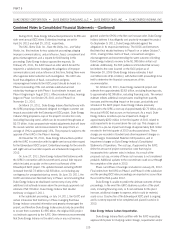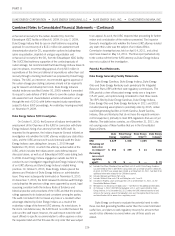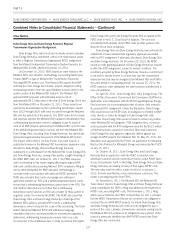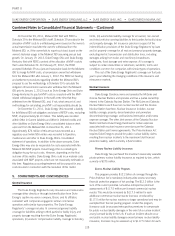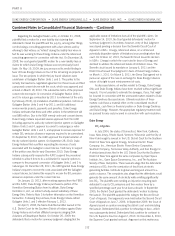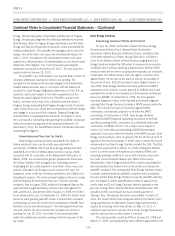Duke Energy 2011 Annual Report Download - page 152
Download and view the complete annual report
Please find page 152 of the 2011 Duke Energy annual report below. You can navigate through the pages in the report by either clicking on the pages listed below, or by using the keyword search tool below to find specific information within the annual report.
PART II
DUKE ENERGY CORPORATION •DUKE ENERGY CAROLINAS, LLC •DUKE ENERGY OHIO, INC. •DUKE ENERGY INDIANA, INC.
Combined Notes to Consolidated Financial Statements – (Continued)
Regarding the Gallagher Station units, on October 21, 2008,
plaintiffs filed a motion for a new liability trial claiming that
defendants misled the plaintiffs and the jury by, among other things,
not disclosing a consulting agreement with a fact witness and by
referring to that witness as “retired” during the liability trial when in
fact he was working for Duke Energy Indiana under the referenced
consulting agreement in connection with the trial. On December 18,
2008, the court granted plaintiffs’ motion for a new liability trial on
claims for which Duke Energy Indiana was not previously found
liable. On May 19, 2009, the jury announced its verdict finding in
favor of Duke Energy Indiana on four of the remaining six projects at
issue. The two projects in which the jury found violations were
undertaken at Gallagher Station Units 1 and 3. The parties to the
remedy trial reached a negotiated agreement on those issues and filed
a proposed consent decree with the court, which was approved and
entered on March 18, 2010. The substantive terms of the proposed
consent decree require: (i) conversion of Gallagher Station Units 1
and 3 to natural gas combustion by 2013 (or retirement of the units
by February 2012); (ii) installation of additional pollution controls at
Gallagher Station Units 2 and 4 by 2011; and (iii) additional
environmental projects, payments and penalties. Duke Energy
Indiana estimates that these and other actions in the settlement will
cost $88 million. Due to the NSR remedy order and consent decree,
Duke Energy Indiana requested several approvals from the IURC
including approval to add a dry sorbent injection system on Gallagher
Station Units 2 and 4, approval to convert to natural gas or retire
Gallagher Station Units 1 and 3, and approval to recover expenses for
certain SO2emission allowance expenses required to be surrendered.
On September 8, 2010, the IURC approved the implementation of
the dry sorbent injection system. On September 28, 2010, Duke
Energy Indiana filed a petition requesting the recovery of costs
associated with the Gallagher consent decree. Testimony in support
of the petition was filed in early December 2010. Duke Energy
Indiana subsequently requested the IURC suspend the procedural
schedule to allow it time to do a solicitation for capacity options to
compare to the proposed conversion of Gallagher Units 1 and 3 to
natural gas. On December 28, 2011, the IURC granted Duke Energy
Indiana’s request to recover the costs associated with the Gallagher
consent decree, but denied the request to recover the SO2emission
allowance expenses under the consent decree.
On January 12, 2012, after receiving approval from the FERC
and the IURC, Duke Energy Indiana purchased a portion of the
Vermillion Generating Station from its affiliate, Duke Energy
Vermillion II, LLC, an indirect wholly-owned subsidiary of Duke
Energy Ohio. Refer to Note 3 for further information on the Vermillion
transaction. Following the purchase, Duke Energy Indiana retired
Gallagher Units 1 and 3 effective February 1, 2012.
On April 3, 2008, the Sierra Club filed another lawsuit in the
U.S. District Court for the Southern District of Indiana against Duke
Energy Indiana and certain affiliated companies alleging CAA
violations at Edwardsport Station. On October 20, 2009, the
defendants filed a motion for summary judgment alleging that the
applicable statute of limitations bars all of the plaintiffs’ claims. On
September 14, 2010, the Court granted defendants’ motion for
summary judgment in its entirety; however, entry of final judgment
was stayed pending a decision from the Seventh Circuit Court of
Appeals in USA v. Cinergy, referenced above, on a similar and
potentially dispositive statute of limitations issue pending before that
court. On October 12, 2010, the Seventh Circuit issued its decision
in USA v. Cinergy in which the court ruled in favor of Cinergy and
declined to address the referenced statute of limitations issue. The
Seventh circuit issued its mandate on January 6, 2011 and the
District Court issued final judgment in favor of Duke Energy Indiana
on March 1, 2011. On March 2, 2011, the Sierra Club agreed not to
pursue an appeal of the case in exchange for Duke Energy Indiana’s
waiver of its right to seek reimbursement of costs.
As discussed above, all matters related to Cinergy, Duke Energy
Ohio and Duke Energy Indiana have been resolved without significant
impacts. It is not possible to estimate the damages, if any, that might
be incurred in connection with the unresolved matters related to Duke
Energy Carolinas discussed above. Ultimate resolution of these
matters could have a material effect on the consolidated results of
operations, cash flows or financial position or Duke Energy Carolinas
and Duke Energy. However, the appropriate regulatory treatment will
be pursued for any costs incurred in connection with such resolution.
Duke Energy
CO2Litigation.
In July 2004, the states of Connecticut, New York, California,
Iowa,NewJersey,RhodeIsland,Vermont,WisconsinandtheCityof
New York brought a lawsuit in the U.S. District Court for the Southern
District of New York against Cinergy, American Electric Power
Company, Inc., American Electric Power Service Corporation,
Southern Company, Tennessee Valley Authority, and Xcel Energy Inc.
A similar lawsuit was filed in the U.S. District Court for the Southern
District of New York against the same companies by Open Space
Institute, Inc., Open Space Conservancy, Inc., and The Audubon
Society of New Hampshire. These lawsuits allege that the defendants’
emissions of CO2from the combustion of fossil fuels at electric
generating facilities contribute to global warming and amount to a
public nuisance. The complaints also allege that the defendants could
generate the same amount of electricity while emitting significantly
less CO2. The plaintiffs were seeking an injunction requiring each
defendant to cap its CO2emissions and then reduce them by a
specified percentage each year for at least a decade. In September
2005, the District Court granted the defendants’ motion to dismiss
the lawsuit. The plaintiffs appealed this ruling to the Second Circuit
Court of Appeals. Oral arguments were held before the Second Circuit
Court of Appeals on June 7, 2006. In September 2009, the Court of
Appeals issued an opinion reversing the district court and reinstating
the lawsuit. Defendants filed a petition for rehearing en banc, which
was subsequently denied. Defendants filed a petition for certiorari to
the U.S. Supreme Court on August 2, 2010. On December 6, 2010,
the Supreme Court granted certiorari. Argument on this matter was
132





